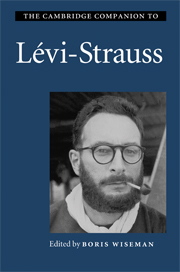Book contents
- Frontmatter
- Introduction
- Part I: Society and culture
- 1 Lévi-Strauss and the question of humanism followed by a letter from Claude Lévi-Strauss
- 2 Lévi-Strauss and history
- 3 Structure and exchange
- 4 The future of the structural theory of kinship
- Part II: Myth and mind
- Part III: Language and alterity
- Part IV: Literature and aesthetics
- Bibliography of works by Claude Lévi-Strauss
- Index
3 - Structure and exchange
from Part I: - Society and culture
Published online by Cambridge University Press: 28 January 2010
- Frontmatter
- Introduction
- Part I: Society and culture
- 1 Lévi-Strauss and the question of humanism followed by a letter from Claude Lévi-Strauss
- 2 Lévi-Strauss and history
- 3 Structure and exchange
- 4 The future of the structural theory of kinship
- Part II: Myth and mind
- Part III: Language and alterity
- Part IV: Literature and aesthetics
- Bibliography of works by Claude Lévi-Strauss
- Index
Summary
Why do groups exchange? Why do the Arapesh say 'Your own pigs, your own yams which you have piled up, you may not eat' (Rosman and Rubel 2004)? You must give them to others. Malinowski also raised this question, asking why men give their finest yams to their brothers-in-law rather than keep them (1965: 188-9)? Why does Lévi-Strauss argue that groups must give their sisters and their daughters to others, rather than keeping them for themselves (1969b)? The answer to all of these questions is the same. By giving your own yams, your own pigs, your sisters and your own daughters to others, you create networks of social relationships, since the rule of reciprocity compels them to give you an equal return.
The things distributed at ceremonies are clues to the nature of the social structural relationship of exchangers. Before one discusses social structure and exchange, one must first deal with the concept of structure. Structuralism as a theoretical concept has had a long history in fields like linguistics, philosophy and biology. Piaget contrasted structuralism with 'the atomistic tendency to reduce wholes to their prior elements' (Piaget 1970: 4). Structuralism's most famous exponent in anthropology, by far, was Claude Lévi-Strauss who applied the theoretical framework of linguistics to the analysis of culture. The linguistic concepts which Lévi-Strauss drew upon were those of Ferdinand de Saussure, Troubetskoy and most importantly Roman Jakobson, who was Lévi-Strauss's friend and colleague. Lévi-Strauss was also influenced by the theoretical views of Franz Boas (a debt he acknowledges in Structural Anthropology (1963a: 6ff.).
- Type
- Chapter
- Information
- The Cambridge Companion to Lévi-Strauss , pp. 59 - 79Publisher: Cambridge University PressPrint publication year: 2009
- 3
- Cited by

